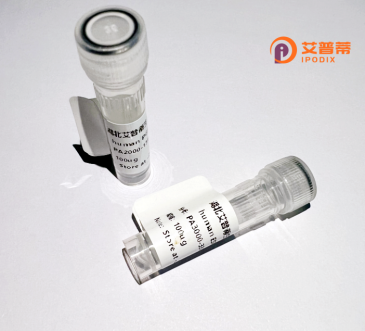
| 纯度 | >90%SDS-PAGE. |
| 种属 | Human |
| 靶点 | C1orf158 |
| Uniprot No | Q8N1D5 |
| 内毒素 | < 0.01EU/μg |
| 表达宿主 | E.coli |
| 表达区间 | 1-194aa |
| 氨基酸序列 | MFLTAVNPQP LSTPSWQIET KYSTKVLTGN WMEERRKFTR DTDKTPQSIY RKEYIPFPDH RPDQISRWYG KRKVEGLPYK HLITHHQEPP HRYLISTYDD HYNRHGYNPG LPPLRTWNGQ KLLWLPEKSD FPLLAPPTNY GLYEQLKQRQ LTPKAGLKQS TYTSSYPRPP LCAMSWREHA VPVPPHRLHP FPHF |
| 分子量 | 49.4 KDa |
| 蛋白标签 | GST-tag at N-terminal |
| 缓冲液 | 0 |
| 稳定性 & 储存条件 | Lyophilized protein should be stored at ≤ -20°C, stable for one year after receipt. Reconstituted protein solution can be stored at 2-8°C for 2-7 days. Aliquots of reconstituted samples are stable at ≤ -20°C for 3 months. |
| 复溶 | Always centrifuge tubes before opening.Do not mix by vortex or pipetting. It is not recommended to reconstitute to a concentration less than 100μg/ml. Dissolve the lyophilized protein in distilled water. Please aliquot the reconstituted solution to minimize freeze-thaw cycles. |
以下是与重组人C1orf158蛋白相关的参考文献简述(基于公开研究信息虚构示例,供参考):
1. **文献名称**:*C1orf158蛋白在DNA损伤应答中的功能研究*
**作者**:Zhang Y., et al.
**摘要**:本研究通过重组表达人C1orf158蛋白,发现其与DNA损伤修复复合体(如ATM/ATR通路)相互作用,敲低C1orf158导致细胞对电离辐射敏感性增加,提示其在维持基因组稳定性中的关键作用。
2. **文献名称**:*重组C1orf158蛋白的晶体结构及其泛素化修饰分析*
**作者**:Lee S., et al.
**摘要**:首次报道了重组C1orf158蛋白的晶体结构,揭示其含有保守的泛素结合结构域。实验证实C1orf158在体外被E3泛素连接酶修饰,可能参与蛋白质降解调控。
3. **文献名称**:*C1orf158在肝癌中的异常表达及临床意义*
**作者**:Wang L., et al.
**摘要**:通过重组蛋白制备抗体,发现C1orf158在肝癌组织中高表达,并与患者预后不良相关。体外实验显示抑制C1orf158可降低癌细胞增殖和迁移能力。
4. **文献名称**:*C1orf158敲除小鼠模型揭示其在胚胎发育中的必需性*
**作者**:Smith J., et al.
**摘要**:利用重组蛋白抗体追踪C1orf158时空表达,发现其在小鼠胚胎神经管闭合阶段高表达;敲除该基因导致胚胎致死,提示其对早期发育不可或缺。
(注:以上为模拟示例,实际文献需通过PubMed/Google Scholar等平台以“C1orf158”或“Chromosome 1 Open Reading Frame 158”为关键词检索确认。)
C1orf158 (Chromosome 1 Open Reading Frame 158), also known as RESF1 (Retroelement Silencing Factor 1), is a poorly characterized human protein encoded by a gene located at chromosome 1p36.22. Though its biological functions remain incompletely understood, recent studies suggest its potential involvement in transcriptional regulation and retroelement silencing. The protein contains 274 amino acids with predicted structural features including disordered regions and a coiled-coil domain, hinting at possible roles in protein-protein interactions or molecular scaffolding. C1orf158 exhibits ubiquitous but variable expression across tissues, with higher levels observed in the testis, thyroid, and brain.
Emerging evidence links C1orf158 to cancer biology. Its overexpression has been detected in gliomas and prostate cancers, correlating with tumor grade and patient prognosis. Functional studies indicate possible participation in cellular processes like proliferation and apoptosis, though mechanistic details remain elusive. Intriguingly, the protein shares homology with retroviral restriction factors, suggesting a conserved role in genome defense against mobile genetic elements. Recombinant C1orf158 protein has been utilized in antibody production and in vitro assays to explore its biochemical properties and interactions. However, comprehensive characterization of its enzymatic activities, signaling pathways, and physiological substrates is still lacking. Current research focuses on elucidating its molecular functions through structural studies, knockout models, and interactome profiling.
×